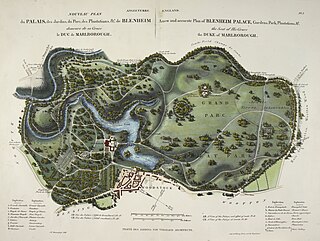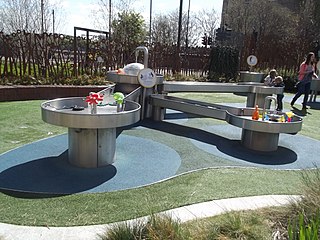
A garden is a planned space, usually outdoors, set aside for the cultivation, display, and enjoyment of plants and other forms of nature. The single feature identifying even the wildest wild garden is control. The garden can incorporate both natural and artificial materials.

Landscape architecture is the design of outdoor areas, landmarks, and structures to achieve environmental, social-behavioural, or aesthetic outcomes. It involves the systematic design and general engineering of various structures for construction and human use, investigation of existing social, ecological, and soil conditions and processes in the landscape, and the design of other interventions that will produce desired outcomes.

The early history of gardening is largely entangled with the history of agriculture, with gardens that were mainly ornamental generally the preserve of the elite until quite recent times. Smaller gardens generally had being a kitchen garden as their first priority, as is still often the case.

A rock garden, also known as a rockery and formerly as a rockwork, is a garden, or more often a part of a garden, with a landscaping framework of rocks, stones, and gravel, with planting appropriate to this setting. Usually these are small Alpine plants that need relatively little soil or water. Western rock gardens are often divided into alpine gardens, scree gardens on looser, smaller stones, and other rock gardens.

Landscape design is an independent profession and a design and art tradition, practiced by landscape designers, combining nature and culture. In contemporary practice, landscape design bridges the space between landscape architecture and garden design.
Garden design is the art and process of designing and creating plans for layout and planting of gardens and landscapes. Garden design may be done by the garden owner themselves, or by professionals of varying levels of experience and expertise. Most professional garden designers have some training in horticulture and the principles of design. Some are also landscape architects, a more formal level of training that usually requires an advanced degree and often a state license. Amateur gardeners may also attain a high level of experience from extensive hours working in their own gardens, through casual study, serious study in Master gardener programs, or by joining gardening clubs.

John Claudius Loudon was a Scottish botanist, garden designer and author. He was the first to use the term arboretum in writing to refer to a garden of plants, especially trees, collected for the purpose of scientific study. He was married to Jane Webb, a fellow horticulturalist, and author of science-fiction, fantasy, horror, and gothic stories.

Andrew Jackson Downing was an American landscape designer, horticulturist, writer, prominent advocate of the Gothic Revival in the United States, and editor of The Horticulturist magazine (1846–1852). Downing is considered to be a founder of American landscape architecture.

The cottage garden is a distinct style that uses informal design, traditional materials, dense plantings, and a mixture of ornamental and edible plants. English in origin, it depends on grace and charm rather than grandeur and formal structure. Homely and functional gardens connected to cottages go back centuries, but their stylized reinvention occurred in 1870s England, as a reaction to the more structured, rigorously maintained estate gardens with their formal designs and mass plantings of greenhouse annuals.

Historic garden conservation is a specialised type of historic preservation and conservation or restoration concerned with historical and landmark gardens and designed landscapes.

The Landscape Institute (LI) is a UK based professional body for the landscape profession. Its membership includes landscape architects, urban designers, landscape planners, landscape scientists and landscape managers. The LI also has a category for academic members.
This is an alphabetical index of articles related to gardening.

Frank Albert Waugh was an American landscape architect whose career focused upon recreational uses of national forests, the production of a highly natural style of landscape design, and the implementation of ecology as a basis for choices in landscape design. He essentially pioneered the role of the landscape architect as an integral part of national forest design and development through such projects as the Mount Hood Scenic Byway and the Bryce Canyon scenic roadway. His ideas spread via his diverse writings, including Recreation Uses in the National Forests and The Natural Style in Landscape Gardening. He also wrote prolifically about education, agriculture, and social issues in such works as The Agricultural College and Rural Improvement.

A playscape is either a piece of land modified for children's play, a particular structure on a playground, or a nontraditional type of play environment. Landscape architects and designers are increasingly using the term to express areas of cities that encourage interaction and enjoyment for all ages. The term was probably first used in the mid-twentieth century, possibly first attributable to the National Institute for Architectural Education in 1957, and associated in the 1960s with the New York-based Playground Corporation of America. It is mentioned by Joe Frost in his 1992 book, Play and Playscapes, referring to attempts to replace or add on to the rubberized surface, metal and plastic of traditional playgrounds.

A gardener is someone who practices gardening, either professionally or as a hobby.

The G59 – 1st Swiss Horticulture Exhibition was the first of two Swiss horticulture exhibitions up until now. It took place from April 25 to October 11, 1959, in Zurich and covered an area of about 37 acres on the right and left banks of lower Lake Zurich. The two separate halves of the exposition were connected by commuter ferries and a specially created cable car.
Plantify.co.uk is an online plant shop based in Windsor, Berkshire (UK) that sells a wide variety of herbaceous and perennial plants. The plant shop supplies over 3150 plants sourced from small British growers and hosts a Plant Finder encyclopedia and free garden design tool.

Foodscaping is a modern term for the practice of integrating edible plants into ornamental landscapes. It is also referred to as edible landscaping and has been described as a crossbreed between landscaping and farming. As an ideology, foodscaping aims to show that edible plants are not only consumable but can also be appreciated for their aesthetic qualities. Foodscaping spaces are seen as multi-functional landscapes which are visually attractive and also provide edible returns. Foodscaping is a great way to provide fresh food in an affordable way.

Gardening in Scotland, the design of planned spaces set aside for the display, cultivation, and enjoyment of plants and other forms of nature in Scotland began in the Middle Ages.
John Andrew Brookes, MBE was a garden and landscape designer. He started designing gardens and landscapes in the late 1950s and designed thousands of gardens. He also taught and lectured about horticulture, landscape and interior design.
















